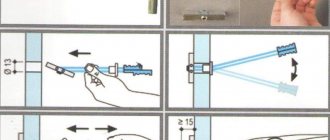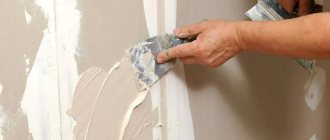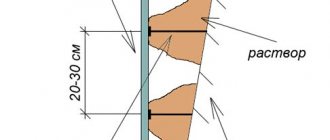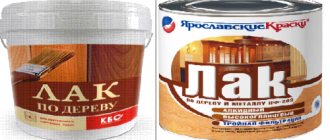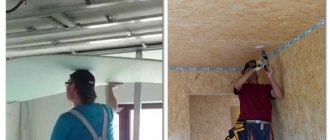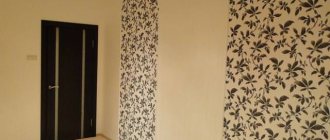The kitchen is a room with high humidity, so protective treatment of the walls during renovation is mandatory. And since in old houses the walls are almost always uneven, it is more convenient to use moisture-resistant drywall. Walls made of gypsum plasterboard or gypsum fiber board are a simple and accessible structure for everyone.
With the help of gypsum boards it is easy to level out the curvature of the base; the material is easy to process and easy to use. There are myths that drywall is too fragile and you can’t even hang a decorative plate on such a wall, not to mention large objects such as kitchen cabinets. Let's dispel this myth and consider options for attaching hanging elements of a kitchen set to a gypsum board wall.
Features of fastening objects on gypsum boards
If you need to hang a simple clock, calendar, portrait or decorative plate on a plasterboard kitchen wall, then you don’t even need to worry about this. The wall will hold up - even with the most ordinary fastening. Drywall does not crack or collapse (unless you intentionally crumble it, of course).
On a note. If you hang light objects on the gypsum board using a dowel, its length should not exceed the thickness of the drywall, otherwise it will begin to crumble.
But what about large items such as a kitchen cabinet or TV? There is a way out and more than one. First of all, it is a strong, reliable mount.
How to Install a Heavy Kitchen Cabinet on Drywall
If you have moved to a new apartment where the partitions are made of plasterboard or the main walls are sheathed with this material, and hanging cabinets cannot be avoided, determine the location of the frame inside the wall. This is quite simple if the walls are not already puttied. But what to do if they already have decorative trim? In this case, a regular magnet will help you.
Next, choose the mounting method. For example, if the distance between the hinges of the cabinets does not coincide with the pitch of the frame racks (in most cases it will not coincide, since the racks are attached in increments of 30-50 cm, and the cabinet width is 80 cm), and the crossbar is installed at an inappropriate height , you will need a rail. It is attached to the sheathing, and modules are already hung on it. In this case, the entire load is taken by the frame racks.
For your information . If you fasten the strip along the entire length of the upper modules of the kitchen unit, the likelihood of the cabinets breaking will be reduced to zero.
If you have a 40 liter aquarium or something very heavy in your kitchen cabinet, it is better to be safe with anchors. These are long bolts that are screwed into the base wall. In this case, it will bear the main load.
You can use cables suspended from the ceiling (if it is not made of plasterboard). Ideally, it is recommended to secure the cables to the supporting beams.
Let's consider these and other methods in more detail.
Technological embedded supports
A reliable solution for partitions is to insert reinforced metal profiles or brackets into the frame at the locations of the planned hanging points for cabinets. Accurate marking of such places will ensure high-quality installation of mortgages.
To enhance the rigidity of the frame, metal sheets are installed on top of the mortgages.
Wood spacer
Distance spacers (brackets, wooden beams) make it possible to perform fastenings at the stage of installation of gypsum plasterboard structures. The essence of the technique is that the cavity of the spacers corresponds to the attachment point. Successful implementation is possible with pre-designed locations of interior objects.
Wooden beams are used with a thickness equal to the width of the frame profiles so that they absorb the load without gaps. Installation is carried out with anchor hardware with a countersunk head to the wall or to the main partition. The edges of the bars are inserted into the profiles. Sometimes, for greater strength, the beams are also connected to each other. It is recommended to use coniferous wood with a thickness of 40 mm or more.
Basic methods of attaching objects to plasterboard walls
Drywall is a composite material consisting of a gypsum core and a cardboard shell. The slabs are loose inside, relatively soft and afraid of moisture. The material itself cannot withstand heavy loads, and this is the whole difficulty of hanging kitchen cabinets on such walls.
The main thing here is not to make a mistake in calculating the attachment points and the expected load.
Installation of embedded beam
A proven method that is actively used. It is acceptable only if the repair has not yet been completed. The beam method is relevant when you know exactly where the furniture will be located.
The essence of the method: even at the stage of creating the frame, a beam is attached to the wall so that it does not protrude beyond the plane of the sheathing. If it is located far from the wall or an interior partition is being erected from plasterboard, on which cabinets will then hang, the mortgage is driven into the frame and attached directly to it.
Why a tree? The easiest way is to add it to your profile at the same time as installing the latter. The cross-section of the timber should not be less than 80-100 mm.
Remember! There should be two embedded timbers, since the wall-mounted kitchen cabinet is attached at the top and bottom. One mortgage will be enough only for the shelf.
Before hanging a cabinet on the already decorated wall of their gypsum boards, they find the mortgage under the finishing layer. If this point was not foreseen, they find the horizontal profile with a magnet, but the easiest way is to mark in the project the height of the beam attachment (the central point of the embed).
Options for mounting a cabinet on a gypsum board wall with a mortgage:
- wood screws;
- dowels of the “quick installation” type;
- dowel-nails with hooks.
The method with an embedded beam is considered the most reliable, since the main load falls on the main wall, and the beam itself is an almost ideal base for hanging heavy objects.
Brief video instructions:
Installation without embedding beam
There are several ways to hang cabinets on drywall in the kitchen without a mortgage: using anchors, to the sheathing, or using cables attached to the ceiling. The last option is suitable only if the kitchen does not have a suspended or suspended ceiling. Ideally, the cable is attached to a supporting beam.
Important! When using the cable method, keep in mind that the load should be evenly distributed across all hangers. Otherwise the cable will break.
Algorithm of actions:
- We drill a hole in the ceiling with a diameter (hereinafter Ø) of 8 mm.
- We screw a G-shaped hook into it. It is important that it fits tightly to the nearby wall, otherwise there will be sagging, distortions, and subsequently the cabinet may even fall off.
- We fasten the cables and hang the cabinets at the required height.
When preparing the cables, cut them correctly: the length of each suspension should exceed the required length by 10 cm.
Mounting a horizontal bus
It is not always possible to provide for hanging kitchen cabinets on a plasterboard wall. Situations can be different: perhaps the purchase of a set was not planned or the room was not originally intended for a kitchen at all. In such a situation, a metal strip will help you.
The slats are horizontally attached to the load-bearing structural elements (frame racks), and cabinets are hung on them.
A horizontal rail is a narrow steel strip that has a special shape and a large number of mounting holes for hardware so that it can be secured to the wall anywhere, depending on the location of the profile.
For your information. To hang a cabinet on such a rail, you will need special brackets that allow you to fix the structure on the rail.
Sequence of work:
- We measure the height of the fastening of the top points of the cabinets, make a mark on the wall on two opposite sides.
- We connect the marking points with a horizontal line and control the level.
- We make the same markings at the place where the lower tire is attached.
- We measure the total width of the hanging modules.
- We trim the upper and lower tires according to the obtained value.
- Using a magnet, we find the frame under the drywall.
- We fasten the tires to the sheathing with self-tapping screws. You can attach the lath directly to the drywall, but such installation cannot be called reliable.
- We hang the cabinets on the rail and level them using the adjusting screws on the brackets.
It is important to secure the tire to the frame in several places. Then the load will be distributed as evenly as possible across the tire and sheathing. If you plan to hang heavy furniture, use a third rail for safety, which is attached in the middle between the top and bottom.
Plastic and metal wrap-around dowels
Plastic dowels are suitable for hanging light and medium-heavy structures. The use of plastic fasteners requires the presence of a lath under a layer of drywall at the fastening point. The “butterfly” and “umbrella” dowels are good because they open up inside a hollow wall and under no circumstances will they allow the screws to break out. Despite the simplicity of this installation, it is reliable in its own way. Lightweight kitchen cabinets, open shelves and decorative elements will hold perfectly on such mounts.
The principle of working with a butterfly dowel is identical to the method with a metal adjustable anchor. “Molly” is a more expensive and high-quality version of the same “butterfly”. And if plastic fasteners raise doubts among many, then the metal analogue will completely dispel them.
Installation method:
- Perform markings. It is convenient to do it together - one places the hung object on the wall in the desired place and holds it while the other levels it and marks the line of the upper fastening.
- At the marking site, drill holes in the drywall and profile Ø 8, 10 or 12 cm, depending on the thickness of the dowel.
- A dowel and a screw are inserted into the hole, which, during the tightening process, presses the dowel closer to the wall and allows its legs to open.
- Cabinets are hung on tightened screws. If the loops are too small, the screws are unscrewed and re-tightened through the loop.
With the help of metal “molly” dowels, the fastening is especially reliable and such hardware can only be pulled out together with a fragment of the plasterboard wall.
Watch the video for the process of hanging kitchen cabinets on a plasterboard wall using molly:
Expandable anchor fastener
Expandable anchors have increased power ratings. Each hardware of this type can withstand up to 35 kg of load. Accordingly, fasteners with two anchors will support a cabinet with a total weight (including contents) of up to 70 kg.
Installation:
- We place the furniture against the wall and make markings in the manner described above.
- We drill through holes in the drywall at the fastening points.
- We insert the anchors into the holes until they stop.
- Tighten the screws until they click.
- We unscrew the screws and re-screw them through the mounting hinges of the cabinet.
If the plasterboard wall is made in one layer, the length of the anchors should be 13 m. For double-layer walls - 26 mm.
Anchor fastening to a solid wall
For heavy cabinets, the estimated weight of which together with utensils exceeds a hundredweight, a more serious method is used. Anchoring into a load-bearing wall is permissible provided that there is this wall and the distance between it and the plasterboard is no more than 5 cm.
Let's do it step by step:
- We carry out the markup (as described in other examples).
- We drill through the drywall according to the diameter of the selected anchor.
- Using a hammer drill or impact drill, we drill a hole in the main wall with a depth of 5 cm. We clean it of construction dust.
- Insert the ripped sleeve of the anchor bolt into the hole.
- We insert a pin into the bushing and screw two nuts onto its outer tip.
- Tighten the top nut with a wrench until the anchor petals open (a slight creaking sound will be heard).
We tighten the second anchor in the same way and fasten the cabinet.
Method 3. Plastic and metal wrap-around dowels
This is the fastest option for hanging a cabinet from a plasterboard wall. The downside is a significant limitation on the maximum load. The video below demonstrates what load different types of dowels can withstand:
For fastening, special roll-up dowels for DRIVA plasterboards are used. They come in metal and plastic, with or without a drilling tip, and have large external threads and a cross slot for screwing into drywall with a screwdriver. In contrast to previous methods, these fasteners should not get into the metal frame profiles.
DRIVA is simply screwed into the plasterboard sheet in the right place, its end is flush with the plane of the wall. The force when screwing should be controlled so that the dowel does not “fall” through the gypsum board. To fasten hanging furniture, self-tapping screws or self-tapping screws are screwed into DRIVA.
The declared maximum load on DRIVA fasteners is 25 kg. At the same time, we should not forget about the additional dynamic loads that arise during operation. Craftsmen recommend using DRIVA for attaching small cabinets, shelves, plasma panels and paintings to drywall.
Another innovative solution is the use of the Fischer DuoTec self-aligning dowel. The principle of its operation and installation technique can be seen in the video:

